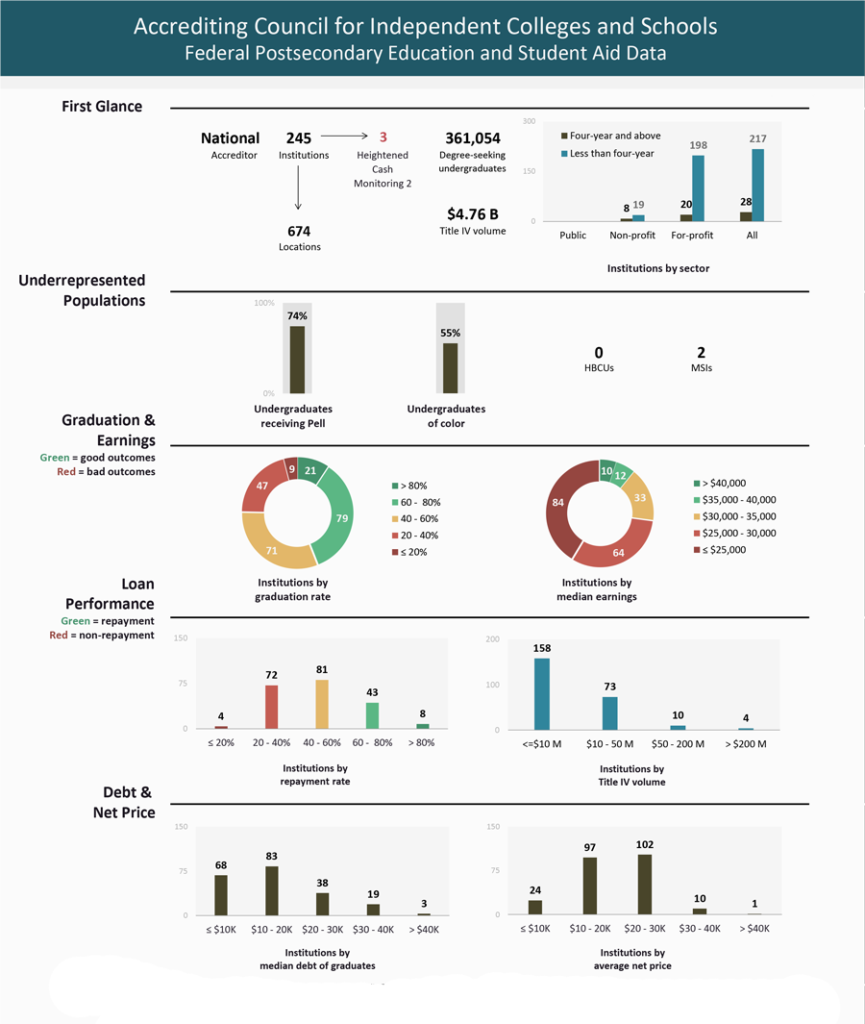While we’ve seen dashboards measuring everything from student completion rates to library circulation patterns, we’ve yet to come across a tool designed to monitor the organizations empowered to watch over the entire higher education system: institutional accreditors. That has changed.
The Department of Education’s (ED) National Advisory Committee on Institutional Quality and Integrity (NACIQI) is piloting a set of dashboards designed to make sense of higher education accreditation. Released in June, NACIQI’s pilot is part of ED’s broader attempt to cast a spotlight on both accreditors and the schools within their accreditation portfolios. While it’s too early to gauge the long-term impact of these dashboards, it is now easier to watch the proverbial watchdogs, and evaluate how well accreditors monitor and improve underperforming schools.
 Source: NACIQI – Recognized Institutional Accreditors: Federal Postsecondary Education and Student Aid Data [PDF]
NACIQI also provides a dashboard showing aggregated data for all Title IV institutions managing more than $132 billion of aid. There are views combining data for all regional and national accreditors responsible for institutions with enrollments of 15.2 million and 840,000 students respectively.
Finally, there are reports for institutions with more than $200 million in Title IV funding volume.
Source: NACIQI – Recognized Institutional Accreditors: Federal Postsecondary Education and Student Aid Data [PDF]
NACIQI also provides a dashboard showing aggregated data for all Title IV institutions managing more than $132 billion of aid. There are views combining data for all regional and national accreditors responsible for institutions with enrollments of 15.2 million and 840,000 students respectively.
Finally, there are reports for institutions with more than $200 million in Title IV funding volume.
 Source: NACIQI – Recognized Institutional Accreditors: Federal Postsecondary Education and Student Aid Data [PDF]
Source: NACIQI – Recognized Institutional Accreditors: Federal Postsecondary Education and Student Aid Data [PDF]
The Regulatory Context
As we’ve noted before, ED has intensified its focus on underperforming schools, often in the for-profit sector. The dramatic closure of ITT Educational Services in early September comes on the heels of ED’s order preventing ITT from enrolling new students with Federal Title IV aid. At the beginning of August, ED rejected an attempt by a for-profit chain, the Center for Excellence in Higher Education, from converting to non-profit status and thereby reducing penalties, such as Gainful Employment regulations. NACIQI’s accreditor dashboard pilot is both timely and relevant. In the context of a heightened regulatory environment, this pilot may expose weaker accreditors by aggregating data of key performance indicators such as institutional graduation rates, median earnings, and loan default. The pilot coincides with a new vigilance over the accreditors in its purview. On September 22, ED formally revoked the status of Accrediting Council for Independent Colleges and Schools (ACICS) a national accrediting agency. ACICS was ITT’s accreditor. NACIQI’s dashboard reports that ITT had access to more than $700 million of Title IV aid, but reported only a 32% graduation rate and a loan default rate of 22%. In NACIQI’s view, ACICS failed to regulate its institutions effectively, thereby calling into question its legitimacy as an accrediting agency. De-recognition of an accreditor is extremely rare: no accreditor with the size and membership of ACICS has ever suffered this penalty. De-recognition of ACICS will have a domino effect on its member institutions. Those institutions seeking to maintain eligibility for Title IV aid for the 400,000 students among them will have to affiliate with a new accreditor, a time-consuming and expensive process.The Pilot in Depth
A legacy of inconsistent enforcement, governance, and terminology has plagued national and regional accreditors alike. Although recognized accreditors must adhere to common principles, each has evolved somewhat distinct formulas for assessing quality and implementing sanctions. As a result, it’s possible for two institutions that have been reviewed by different accreditors to receive different penalties for similar infractions. Before NACIQI’s pilot, it was necessary to wade through disparate repositories of financial aid data and school performance to assess the effectiveness of an accreditor. According to NACIQI, it designed the pilot to create a “more systematic approach to considering student achievement and other outcome and performance metrics.” The NACIQI pilot dashboards collate data from the Postsecondary Education Participants System (PEPS), the Federal Student Aid Database, and the College Scorecard. It presents the data in the following five sections:- First Glance: Member institutions, enrollments, Title IV aid, and institutions by sector
- Underrepresented Populations: Pell recipients and students of color
- Graduation and Earnings: Percentages of institutions by graduation rate and median earnings
- Loan Performance: Percentages of institutions by repayment rate and Title IV volume
- Debt and Net Price: Institutions by median debt and net price
 Source: NACIQI – Recognized Institutional Accreditors: Federal Postsecondary Education and Student Aid Data [PDF]
NACIQI also provides a dashboard showing aggregated data for all Title IV institutions managing more than $132 billion of aid. There are views combining data for all regional and national accreditors responsible for institutions with enrollments of 15.2 million and 840,000 students respectively.
Finally, there are reports for institutions with more than $200 million in Title IV funding volume.
Source: NACIQI – Recognized Institutional Accreditors: Federal Postsecondary Education and Student Aid Data [PDF]
NACIQI also provides a dashboard showing aggregated data for all Title IV institutions managing more than $132 billion of aid. There are views combining data for all regional and national accreditors responsible for institutions with enrollments of 15.2 million and 840,000 students respectively.
Finally, there are reports for institutions with more than $200 million in Title IV funding volume.
 Source: NACIQI – Recognized Institutional Accreditors: Federal Postsecondary Education and Student Aid Data [PDF]
Source: NACIQI – Recognized Institutional Accreditors: Federal Postsecondary Education and Student Aid Data [PDF]

